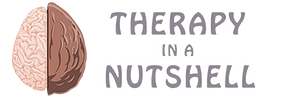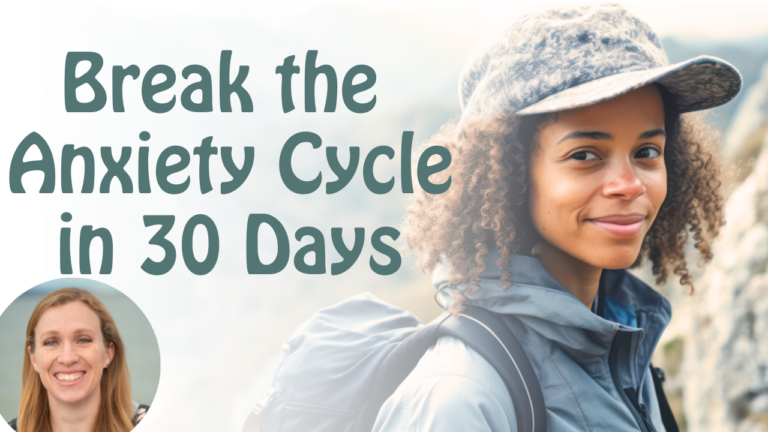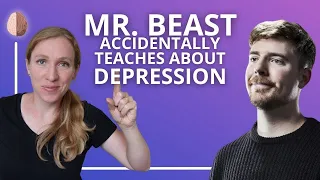In this video, you can explore an effective breathing exercise for anxiety. You’ll learn a deep breathing technique to combat anxiety.
OK, so anxiety is a state of your nervous system– it is when your autonomic nervous system is activated. This can be triggered by actual danger (a real threat, in the present moment) but just as easily by a perceived danger- (a threat that you imagine, that you worry about, that is so far removed from a physical threat that you don’t even realize why you’re having a physical response).
The autonomic nervous system is the part of our nervous system that we don’t directly control. That’s why you can’t just say “Calm down” and it works- EXCEPT- there are people who can. They’ve literally trained their nervous system to calm down upon command.
So let’s explore how you can use breathing to send a message from your body to your brain that you are safe, and turn down the anxiety response.
Now we’re going to be exploring our anxious and calming responses in our body, if you want more feedback from yoru body you can get a heart rate monitor and watch yourself as you do this. Or just find your pulse and explore what happens.
Exploring the Breath: Put One Hand on your Chest and One on your Stomach.
Take just a few breaths naturally- how you would normally breathe- what do you notice? Which hand moves? For many people their shoulders lift or their chest rises, their stomach is tight. For some people they hold their breath – throughout the day – notice how it feels to hold your breath- it’s something we naturally do when we’re scared, tense, uncertain. It’s an aspect of the freeze response.
Now take a few fast intakes of breath-this is an activating breath- when we’re startled, we take a sharp intake of breath. What do you feel? For many people this activates- it increases heartrate, it’s something our body does to prepare for action.
Now Hold and sigh, do a long slow out breath. This is a – natural tension release built into your nervous system, it releases tension instead of acting out.
HRV
Now find your pulse and pay attention to what happens when you breathe in. When you breathe out. Can you notice a change in your heart rate?
So long, slow outbreaths slow the heart rate, they send a message from your body to your brain to calm down. This is two directional messaging. Your mind can tell your body to be activated or relaxed and your body can tell your mind to be activated or relaxed.
OK, now that you’ve explored how changing your breathing changes your body’s state, let’s talk about how you can use your breathing to calm anxiety.
A reminder. With all aspects of anxiety, you can’t force it, if you find yourself trying to force yourself to breathe deeper, or getting anxious about your breathing or struggling against anxiety, drop the rope, go back to your default mode of acceptance, notice and allow the sensations to be there, say “bring it on”
Trying to force yourself to calm down is essentially telling your body that its own sensations are a threat, it’s putting yourself into perceived danger. If you find yourself thinking “I can’t feel this way” “I have to calm myself down” then you’re sending a message to your brain that you are in danger from your own sensations. If you find yourself doing this, take a step back and go back to willingness, you can make space for your feelings, you can feel them and be ok. Sensations won’t harm you.
That being said, you can’t push a rope, but you can pull it. If you are gentle and compassionate, you can escape the anxiety cycle by using your body to calm your mind. To turn on that parasympathetic response.
Benefits of Slow Breathing
The New York Times reports “Consciously slowing (breathing)… to between five to seven breaths per minute at rest — can help reduce blood pressure, regulate heart rate and lift mood. Researchers have also reported that breathing slowly can reduce chronic pain, stress and depression, and bolster fitness and energy levels. One study… found that even just focusing on the way you naturally breathe, when paired with other mindfulness practices, was as effective as drugs to treat anxiety disorders.”
So what’s happening here? Your body has a feedback loop- it uses the vagal nerve to send messages from your brain to your body, and from your body to your brain. So when your breathing slows, it sends a message to your brain that “You are safe. You can turn off the anxiety response now”. This reaction is called the Vagal Brake. The vagal brake is our body’s built-in system to slow heart rate, lower blood pressure, regulate breathing and digestion and help you relax.
Teaching Breathing
You can do two things with breathing, you can calm your body down in the moment, but the more you practice slow breathing, and other parasympathetic exercises, the more you strengthen vagal tone, it’s like the muscle that you can use to calm yourself down. Monks who train for hours every day can change their heart rate with a word or a thought. And you can learn it too.
Belly Breathing
Simple belly breathing exercise – Belly breathing or diaphragmatic breathing triggers the parasympathetic response in your nervous system. So let’s begin.
It can be easiest to learn this if you start on the floor, but afterwards I will also show you how to do it in a chair.
Lay down flat on your back and place your hand on your chest and one hand on your belly button.
If we do it sitting up- you may notice the common difficulty people face- they breathe with their shoulders instead of their stomach. This is compensation for poor posture or a modification of stress breathing. So watch out for that. Place your hand on your stomach and see if you can notice the stomach muscles engage first. Before the chest muscles.
Also, breathing IN too deeply or forcefully can cause some people to hyperventilate, so focus more on just allowing your stomach to move gently up and down, loosely, without lifting the shoulders.
That’s why the next thing to learn is actually my preferred technique, with slow breathing or paced breathing.
The goal with paced breathing is to simply slow the breath and lengthen the outbreath. It takes some exploring to figure out what’s the right pace for you.
Start with In 4 – Out 6 – Pause 2 to find the right pace. If you imagine your breath as a wave, you want it to look smooth and steady with gentle peaks and valleys, not sharp starts and stops or breath holding. AS you breathe slowly, remember to relax your shoulders and allow your stomach to rise.
You can use a guided video or apps to remind you to practice several times a day. I’ll link some good ones below.
Breathing for Panic and Anxiety
There’s one more way you can use breathing, if you’re non-forceful with yourself, you can use slow breathing during a crisis or panic. So if you feel yourself getting worked up, you can remind yourself to breathe slowly and gently, and sometimes this can help you calm down in a stressful moment.
If you are doing exposure therapy work or preparing to do so, when you are doing imaginary exposure, you can use slow breathing to reduce anxiety. Breathing this way can move brain waves into an alpha rhythm which is relaxed but alert.
But again, we can’t force it. If you find this backfiring- take my how to process emotions course- because you’re getting stuck in struggle. I’ve also got a series of videos at the end of the course about how to deal with panic attacks.
Coping vs. Exercise
And lastly, it’s important to remember there is a difference between a coping skill and an exercise. A coping skill might help us calm down in the moment or get us through a difficult situation, but an exercise is something we need to practice regularly to build up strength.
You can actually measure the strength of your parasympathetic response, aka vagal tone, through your HRV.
We talked about strengthening your vagal tone on day 22, but the important thing to remember is that if you want a resilient parasympathetic response, you should practice slow breathing throughout the day. This trains your nervous system to have a strong calming ability.
I encourage you to do one week where you take a few slow breaths on average every 15 minutes throughout the day. You can use the app lotus bud to remind yourself to do this or.This is going to be a little difficult at first, but soon it will become natural to notice your state, and trigger that relaxation response with a few slow breaths.
We can strengthen our vagal tone by practicing breathing a few times each day, again, our vagal tone is like a muscle, what we exercise we get more of. If we exercise our parasympathetic response, it will get better at helping us calm down.
So it’s important that you don’t wait until you feel anxious to practice slow breathing, use it throughout the day to regulate your nervous system and train your parasympathetic response to turn on. This is one of the most effective ways to use breathing to manage anxiety.
OK, I hope this was helpful, thanks for watching and take care!
Click the link below to learn about the course, Break the Anxiety Cycle in 30 Days.





